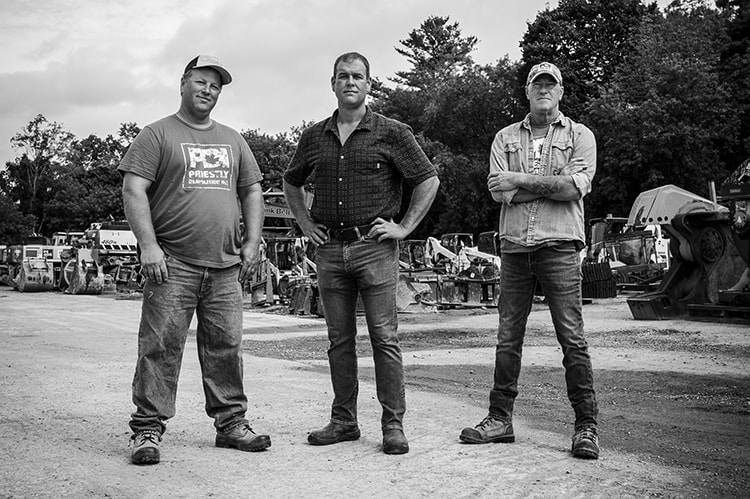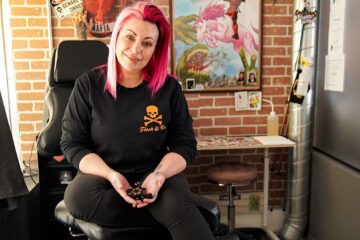Priestly Demolition: It’s The Mystery Of What Is Inside
World Demolition Award winners, the innovative, fun-loving family-owned Priestly Demolition is a force with which to be wrecking.
Ghost whisperers. Safe crackers. Storytellers. Laughter lovers. World Demolition Award winners. Ready, willing and able to take down buildings, bridges and lighthouses (not to mention anything else that needs to be flattened). Meet Ryan Priestly, president of Priestly Demolition; Ted Finch, head of salvage materials and equipment sales; and Justin Fortin, who is Finch’s right-and left-hand man. “Which leaves me a hands-free guy,” Fortin laughs.
Priestly Demolition, a family-owned business, has a staff who like to quip that they are a “force to be wrecking with” and are exceptionally passionate about all that they do. With a rambunctious love for fun and a ready-to-laugh spirit that ripples throughout our conversation, the crew is nevertheless team tight and serious when they have to be — everyone’s safety on the job site is, of course, priority No. 1.
The challenges and the variety of work on the company’s many projects are what all three of our interviewees say they love about their jobs. “Every day there is some new challenge, with a lot of problem-solving involved. And in order to produce work quicker than other companies, we build our own specialty equipment,” Priestly says.
Finch, who has been with the company for eight years, loves the salvaging part of the business because he hates seeing junk going to landfills. “I like to recycle and I like to salvage stuff and keep it out of landfills,” he says. “I also like turning a buck.”
It is this philosophy of salvaging and ultimately uncovering treasures, discovering the diamonds in the rough, so to speak, that sparked interest in the creation of the team’s new show, Salvage Kings, which premiered Sept. 15 on the History Channel and is slated for 10 episodes. “You will not believe how handsome I am,” Fortin says with a laugh.
But the actual process of unearthing valuable items before the demolition trucks come in is one that is chaotically fast-paced and on the clock. “Sometimes we have only a half-day or a day to get into the building. It is a race against time, often without much notice. We are literally in the building and the demolition team is starting to wreck at the other end,” Finch says.
The No. 1 skill set for salvaging is knowing the market and the value of an item, followed by both how the team is going to get the piece out and how much that is going to cost. And while money is always a factor when running a business, one of the things that Finch loves most about salvaging is following items that have been sold. “Every time I go into a building I wonder, ‘Who lived here?’ I like to feel that out; I love the story behind the story. I love seeing the different paints, or maybe there might be a marking on the closet wall from a kid being measured when he was growing up. I find something in every building and I think, ‘I have to look into this more,’” Finch says. “It piques my interest — it’s a part of me now.”
And while neither Finch nor Fortin want to spoil the fun around the found treasures profiled in their show, they mention uncovering a log cabin inside of a house they were about to demolish. Neither of them, when questioned, however, claims to know how it got there. “Tune in to our show,” Finch says.
“Every day there is some new challenge, with a lot of problem-solving involved. And in order to produce work quicker than other companies, we build our own specialty equipment” — Ryan Priestly
Other bizarre items uncovered in the demolition process include a formaldehyde-preserved hand in a jar found in the basement of a hospital. “We took the jar to the meeting with the owners and consulting firm and said, ‘Here’s your jar back. We are getting paid to tear down the building, not dispose of body parts,’” Finch says. “The guys were freaked out about it.”
Finch also says that a lot of the buildings are haunted, but he finds that most of the ghosts are friendly. “I just say, ‘Get out of here — the big machines are coming,’” he says with a laugh.
“I walk into a building, and Ted is talking to spirits,” Fortin adds. “I was weirded out at first, but now we just tell the ghosts, ‘We are not here to hurt you.’”
One of the spookiest places that Priestly was involved in demolishing was the old Don Jail. “Walking around and seeing the cells, and knowing that there were three people to each cell, that was really eerie,” Finch says. “But we have sold a few hundred cell doors from that jail.”
Experience and the fact that Finch has, from the time he was a kid, always been into old things and assessing their value are big pluses. As an antique dealer and a restoration expert, he has been to hundreds of auctions and watched the trends — how things are valued. “You have to keep up with what people want and what the design trends are,” he says.
Of course, how could a person be immersed in the uncovering of newfound treasures on a daily basis and not end up as a collector of the weird, wonderful and abstract? “I’m really into nostalgic items, things like soda machines and toys,” Finch says.
“You should have seen his face when he found this toy,” Fortin says. “It is just so much better finding something than buying it.”
Finch also loves century safes, and Fortin is the man to drill through them to discover what’s inside. “Safes always get my blood pressure going. But if I found a million dollars in one of them, I don’t know if I’d tell you,” Finch laughs. “It is the pirate in all of us.”
As with most intriguing self-made successes, Priestly Demolition, originally called Vic Priestly Contracting Limited, was started by Ryan’s dad, Vic, more than 40 years ago. “My dad quit school halfway through Grade 10 because he couldn’t find the people to keep up with the snow removal contracts he had,” Priestly says. “After he moved to the Aurora, Ont., area in 1969, when he was 20, he got an appetite for other work — landscaping, grading, things like that. In the early 1980s he won a contract to take down a couple of houses. At that time, salvaging was a big deal, and we had a property with a big barn on it that Dad would fill. By 1988, Dad had started a small demolition business, and in 1993 he joined the union. Twenty-five years later, here we are.”
From an original staff of 10, the company now employs 300 people. While the overall market has grown, the fact that Priestly Demolition is so diversified separates the company from its competition. “We do not work in one silo,” Priestly says. “Along with demolition work, we do concrete crushing, work by the hour, equipment rentals and salvaging. We are not afraid to travel, either — we’ve gone to Thunder Bay, Ont., Ottawa, Prince Edward Island and Virginia,” he says.
“There are jobs that people don’t have a clue as to how to do, and Ryan will figure it out with the team,” adds Finch.
An example of this is the demolition of the Nipigon Bridge, where Priestly’s innovation and his planning was singularly original. In fact, it was this project that won the company the World Demolition Award, a contest that companies from all over the world enter. “The stuff Ryan invented and his innovation was unbelievable,” Finch says.
For Finch, being an active salvager means he is keeping stuff out of the landfill. “Priestly was green conscious long before it got trendy,” he says. “We divert at least 95 per cent of complete building structures away from community landfills. There is a big infrastructure around the recycling — which we sell for reuse. Someone will phone up and ask if we have a particular item — like a pedestrian bridge — and I say, ironically, ‘We do.
















































































